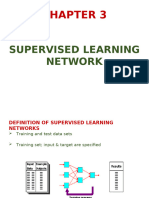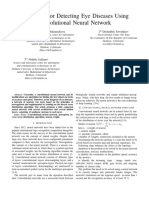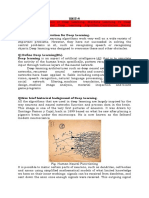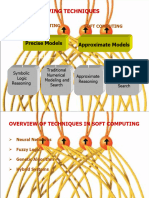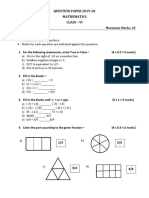Chapter 9
Uploaded by
Raja ManikamChapter 9
Uploaded by
Raja Manikam10/2/2001
Soft Computing: Neural Networks
Soft Computing: Neural Networks
Outline
Introduction Categories Hopfield Net Perceptron Single Layer Multi Layer
Neural Networks
(Chapter 9)
Kai Goebel, Bill Cheetham GE Corporate Research & Development
goebel@cs.rpi.edu cheetham@cs.rpi.edu
Soft Computing: Neural Networks
Soft Computing: Neural Networks
Introduction
Human brain is superior to digital computer at many tasks + e.g., processing of visual information + robust and fault tolerant (nerve cells in the brain die every day) + flexible; adjusts to new environment + can deal with information that is sparse, imprecise, noisy, inconsistent + highly parallel + small, compact, dissipates very little power - slower in primarily (simple) arithmetic operations
3 4
Neurons
McCulloch & Pitts (1943) - simple model of neuron as a binary threshold unit
- uses step function to fire when threshold is surpassed x1 w1
x2 x3 w2 w3
Soft Computing: Neural Networks
Soft Computing: Neural Networks
Real Neurons
Real Neurons - use not even approximately threshold devices - it is assumed they use a non-linear summation method - produce a sequence of pulses (not a single output level) - do not have the same fixed delay (t-> t+1) - are not updated synchronously - amount of transmitter substance varies unpredictably
5 6
Issues
What does that leave us with? What is the best architecture? (layers, connections, activation functions, updating, # units?) How can it be programmed? (can it learn, # examples needed, time to learn, amount of supervision, real-time learning) What can it do? (how many tasks, how well, how fast, how robust, level of generalization)
Page 1
10/2/2001
Soft Computing: Neural Networks
Soft Computing: Neural Networks
Neural Nets: Categorization
Supervised Learning
Multilayer perceptrons Radial basis function networks Modular neural networks LVQ (learning vector quantization)
Supervised Neural Networks
Requirement: known input-output relations
Reinforcement Learning
Temporal Difference Learning Q-Learning
Unsupervised Learning
Competitive learning networks Kohonen self-organizing networks ART (adaptive resonant theory)
7 8
input pattern
output
Soft Computing: Neural Networks
Soft Computing: Neural Networks
Hopfield Model
Associative Memory is considered the fruit fly of this field. It illustrates in the simplest possible manner the way that collective computation can work. Store a set of patterns in such a way that when presented with a new pattern, the network responds by producing the closest stored pattern. Conventional approach: store a list of patterns, compute the Hamming distance, find the smallest, et voila!
9 10
Hopfield Network Operation
Picture is pattern; stored as attractor in the configuration space. From arbitrary starting points, one attractor will be found
Soft Computing: Neural Networks
Soft Computing: Neural Networks
Hopfield Network Operation
Picture is pattern; stored as attractor in the configuration space. From arbitrary starting points, one attractor will be found
Hopfield Architecture
- Recurrent Network - Symmetric Architecture - Evaluation until no more changes are observed i.e., network settles into local minimum config.
wij
- local minimum corresponds to energy function
11 12
E=
1 w x x 2 i , j ij i j
Page 2
10/2/2001
Soft Computing: Neural Networks
Soft Computing: Neural Networks
Hopfield Network Equations
The operative equation, i.e., the network output at each step is
yi = sgn wij x j i
Learning in Hopfield Models
Learning Rule:
( ( wijn + 1) = wijn ) + xi x j
wii = 0
where
1 if x 0 sgn( x ) = - 1 if x < 0
13
14
Soft Computing: Neural Networks
Soft Computing: Neural Networks
Hopfield Example
Learn x=[1 1 -1 -1] which gives us the weight matrix w=[0 1 -1 -1 1 -1 -1 -1 1 0]
1 wij w14=-1 w13=-1 w12=-1 w34=-1 2 3 w23=-1 w24=-1 4
Hopfield Example
Learn second pattern x=[-1 -1 1 1] which gives us the new weight matrix w=[0 2 -2 -2 2 0 -2 -2 -2 -2 0 2 -2 -2 2 0] Now lets check the slightly corrupted pattern p=[-1 -1 -1 1] which will restore the pattern y=[-1 -1 1 1] with an energy level of E=-12
16
0 -1 -1 0 -1 1
Now lets check the slightly corrupted pattern p=[1 1 -1 1] which will restore the pattern found close y=[1 1 -1 -1]
15
with an energy level of E=-6
Soft Computing: Neural Networks
Soft Computing: Neural Networks
More Complex Hopfield Examples
Reconstruction of Images
Hopfield Book Example
Character Recognition
eight exemplar patterns
17
binary images are 130x180 pixels
18
output pattern for noisy 3 input
Page 3
10/2/2001
Soft Computing: Neural Networks
Soft Computing: Neural Networks
Hopfield: Issues
- Other memories can get lost - Memories are created that were not supposed to be there - crosstalk: if there are many memories, they might interfere - no emphasis on learning; rather handcrafting to get desired properties - goes towards optimization
Perceptrons
-Rosenblatt: 1950s -Input patterns represented is binary -Single layer network can be trained easily -Output o is computed by
n o = f wi xi i =1
where wi is a (modifiable) weight xi is the input signal
20
19
is some threshold (weight of constant input) 1 if x > 0 f(.) is the activation function f ( x ) = sgn( x ) = 0 otherwise
Soft Computing: Neural Networks
Soft Computing: Neural Networks
Single-Layer Perceptrons
Network architecture
x1 x2 x3 w1 w2 w3 y = signum(wi xi + w0) w0
Single-Layer Perceptron
Example: Gender classification (according to Jang)
Network Arch. w1 w2 v (voice freq.) h w0 y v Training data
y = signum(hw1+vw2+w0) =
21 22
-1 if female 1 if male h (hair length)
Soft Computing: Neural Networks
Soft Computing: Neural Networks
Perceptron
Learning: select an input vector if the response is incorrect, modify all weights
wi = t i x i
ADALINE
single layer network (conceived by Widrow and Hoff) output is weighted linear combination of weights
o = wi xi w0
i =1 n
where ti is a target output is the learning rate
error is described as (for pattern p) E = (t o )
2 p p p
where If a set of weights for converged state exists, then a method for tuning towards convergence exists (Rosenblatt, 1962) tp is the target output op is the actual output
23
24
Page 4
10/2/2001
Soft Computing: Neural Networks
Soft Computing: Neural Networks
ADALINE
To decrease the error, the derivative wrt the weights is taken
E p = 2 t p o p xi wi
ADALINE and MADALINE
+ Simplicity of learning procedure + Distributed learning; can be performed locally at node level + on-line (pattern by pattern) learning + connect several ADALINEs to MADALINEs to deal with XOR problem + were used for noise cancellation, adaptive inverse control - only one layer; no suitable training method for multi-layer perceptron why?
26
The delta rule is:
p wi = t p o p x i
Intuitive appeal: if tp>op, boost op by increasing wixi increase wi if xi is positive
25
decrease wi is xi is negative
Soft Computing: Neural Networks
Soft Computing: Neural Networks
XOR
Minsky and Papert reported a severe shortcoming of single layer perceptrons, the XOR problem x1 x2 output 1 x O 0 0 0 0 1 1 1 0 1 0 O x 1 1 0 0 1 not linearly separable
XOR
Minsky and Papert reported a severe shortcoming of single layer perceptrons, the XOR problem x1 x2 output 1 x O 0 0 0 0 1 1 1 0 1 0 O x 1 1 0 0 1 not linearly separable
0 w1 + 0 w 2 + w0 0 w0 0 0 w1 + 1w 2 + w0 > 0 w 2 > w0 1w1 + 0 w 2 + w0 > 0 w1 > w0
27
28
1w1 + 1w 2 + w0 0 w1 + w2 w0
Soft Computing: Neural Networks
Soft Computing: Neural Networks
Enter the Dark Ages of NNs
which (together with a lack or proper training techniques for multi-layer perceptrons) all but killed interest in neural nets in the 70s and early 80s.
29
30
Page 5
10/2/2001
Soft Computing: Neural Networks
Soft Computing: Neural Networks
Multilayer Perceptrons
Two-layer perceptron
1.5
Two-Layer Perceptron: XOR
Node output as surface of their two inputs
1.5
x1 x2
+1 +1 +1 +1 0.5
x3
-1 +1 0.5
x1
+1 +1
x3 -1 +1 +1 x5
x5
x2
+1 0.5
x4
0.5
x4
31
32
note location of o and x
Soft Computing: Neural Networks
Soft Computing: Neural Networks
Multilayer Perceptrons (MLPs)
Network architecture
x1 x2 y1 y2 hyperbolic tangent or logistic function
Multi-Layer Perceptrons
-Recall the output
n o = f wi xi i =1
-and the squared error measure E = (t o ) which is amended to
2 p p p
Ek =
(
n k =1
t k p ok )
-and the activation function
f (x ) = 1 1 + ex
Learning rule:
33
or
f (x ) =
Steepest descent (Backprop) Conjugate gradient method All optim. methods using first derivative Derivative-free optim.
34
1 e x x = tanh 2 1 + e x
or
f (x ) = x
then the learning rule for each node can be derived using the chain rule...
Soft Computing: Neural Networks
Soft Computing: Neural Networks
Multi-Layer Perceptrons
-Recall the output
n o = f wi xi i =1
Backpropagation
make incremental change in the direction dE/dw to decrease the error.
(
n k =1
-and the squared error measure E = (t o ) which is amended to
2 p p p
Ek =
t k p ok )
The learning rule for each node can be derived using the chain rule... to propagate the error back through a multilayer perceptron. E
parameters
-and the activation function
f (x ) =
1 0.5 0 y
1 1 + ex
or
f (x ) =
1 e x = tanh 2 1 + e x
1 0.5 0 -0.5 -1 -10 -5 0 5 10
or
f (x ) = x
-0.5 -1 -10 0 x 10
squashing functions
35
36
w ki =
p
E p w ki
Page 6
error
10/2/2001
Soft Computing: Neural Networks
Soft Computing: Neural Networks
Back-prop procedure
1. Initialize weights to small random values 2. Choose a pattern and apply it to input layer 3. Propagate the signal forward through the network 4. Compute the deltas for the output layer 5. Compute the deltas for the preceding layers by propagating the error backwards 6. Update all weights 7. Go back to step 2 and repeat for next pattern 8. Repeat until error rate is acceptable
37 38
Step 3
Propagate signal forward through the network
Oim = g
w
j
m m 1 ij O j
until all outputs have been calculated For m=0 (input layer), the output is the pattern.
Soft Computing: Neural Networks
Soft Computing: Neural Networks
Step 4
Compute the deltas for the output layer
iM
= g hiM tip OiM
Step 5
( )[
Compute the deltas for the preceding layers by propagating the errors backwards
im1 = g him1
( )w
n j
m m ij j
by comparing the actual output O with the target output t for the pattern p considered
for m=M, M-1, M-2, until a delta has been calculated for every unit
39
40
Soft Computing: Neural Networks
Soft Computing: Neural Networks
Step 6
Use
m wij = imOm1 j
Step Size, Initial Weights
Step size: too big variable: compute error backpropagate compute error again if error bigger, reduce step size (0.5) otherwise, increase a little (1.1) Initial weights: randomize (= 0)
error
too small
to update all connections to
new wij old = wij
+ wij
41
42
Page 7
10/2/2001
Soft Computing: Neural Networks
Soft Computing: Neural Networks
Momentum
If error minimum in long narrow valley, then updating can happen to zig-zag down the valley
Overfitting
Error on learning cases
error
epoch
Error on validation cases
error
smoothes weight updating can speed learning up
43
w = w E + w prev
44
epoch
trained things that are accidental and unimportant
Soft Computing: Neural Networks
Soft Computing: Neural Networks
Local Minima
There is no guarantee that the algorithm converges to a global minimum
error
Architectures and other Techniques
Normalize weights move weights same Euclidean distance each epoch Data scaling Input scaling: allows weights to have same order of magnitude Output scaling: let target go between +- 0.9 to avoid saturation What number of nodes per layer? How many layers?
epoch
- check with different initial conditions (different weights, etc.)
45
- perturb the system (data) with noise to improve result
46
Soft Computing: Neural Networks
Soft Computing: Neural Networks
MLP Decision Boundaries
XOR 1-layer: Half planes
A B B A A B
Radial Basis Function (RBF) Networks
General
Interwined
Network architecture
x1 x2 y1 y2
2-layer: Convex
A B
B A A B
Each node is described by a bell shaped function
xc i oi = exp 2 i2
2
3-layer: Arbitrary
A B
B A A B
47
48
where ci is the center of the curve
Page 8
10/2/2001
Soft Computing: Neural Networks
Soft Computing: Neural Networks
RBF
Output: weighted sum weighted average linear combination Location of Center: Use (fuzzy) k-means clustering Size of Variance: Use knn-classifier and take average distance
x 0 0 1 1
XOR, revisited
y 0 1 0 1 output 0 1 1 0
49
50
Soft Computing: Neural Networks
Soft Computing: Neural Networks
RBF and FIS
Consider the radial basis functions:
1.0
Modular Networks
Task decomposition Local Experts Fuse information
local expert 1
O1
c1
c2
c3
Input x
and a linear combination of the output variables
y i = a i o + bi
51
local expert 2 ... local expert n
O2
weigh experts opinions by gi
fuse
On
then the response is equivalent to ...
Soft Computing: Neural Networks
53
52
last slide
Page 9
You might also like
- XXXX XXXX 6322: XXXX XXXX 6322 XXXX XXXX 6322No ratings yetXXXX XXXX 6322: XXXX XXXX 6322 XXXX XXXX 63221 page
- Application of Digital Signal Processing in Radar: A StudyNo ratings yetApplication of Digital Signal Processing in Radar: A Study4 pages
- Neural Networks (Review) : Piero P. Bonissone GE Corporate Research & DevelopmentNo ratings yetNeural Networks (Review) : Piero P. Bonissone GE Corporate Research & Development16 pages
- Institute For Advanced Management Systems Research Department of Information Technologies Abo Akademi UniversityNo ratings yetInstitute For Advanced Management Systems Research Department of Information Technologies Abo Akademi University41 pages
- Machine Learning: Lecture 4: Artificial Neural Networks (Based On Chapter 4 of Mitchell T.., Machine Learning, 1997)No ratings yetMachine Learning: Lecture 4: Artificial Neural Networks (Based On Chapter 4 of Mitchell T.., Machine Learning, 1997)14 pages
- Chapter 6 - Artificial Intelligence notesNo ratings yetChapter 6 - Artificial Intelligence notes13 pages
- Artificial Neural Networks: System That Can Acquire, Store, and Utilize Experiential Knowledge100% (1)Artificial Neural Networks: System That Can Acquire, Store, and Utilize Experiential Knowledge40 pages
- D.Y. Patil College of Engineering, Akurdi Department of Electronics & Telecommunication EngineeringNo ratings yetD.Y. Patil College of Engineering, Akurdi Department of Electronics & Telecommunication Engineering41 pages
- Unit 2 Deep Learning and Neural NetworksNo ratings yetUnit 2 Deep Learning and Neural Networks38 pages
- Machine Learning: Lecture 4: Artificial Neural Networks (Based On Chapter 4 of Mitchell T.., Machine Learning, 1997)No ratings yetMachine Learning: Lecture 4: Artificial Neural Networks (Based On Chapter 4 of Mitchell T.., Machine Learning, 1997)14 pages
- Multi-Dimensional Neural Networks: Unified Theory: Garimella RamamurthyNo ratings yetMulti-Dimensional Neural Networks: Unified Theory: Garimella Ramamurthy22 pages
- Introduction To Artificial Neural NetworksNo ratings yetIntroduction To Artificial Neural Networks70 pages
- Aem LMCG WJ 1 Rs RDL RQOFH39 BZ K3 N 8 P 3 CL 8 D3 V Wit BNo ratings yetAem LMCG WJ 1 Rs RDL RQOFH39 BZ K3 N 8 P 3 CL 8 D3 V Wit B4 pages
- Neural Networks: - Genetic Algorithms - Genetic Programming - Behavior-Based SystemsNo ratings yetNeural Networks: - Genetic Algorithms - Genetic Programming - Behavior-Based Systems74 pages
- Machine Learning Using Neural Networks: Presentation By: C. Vinoth Kumar SSN College of EngineeringNo ratings yetMachine Learning Using Neural Networks: Presentation By: C. Vinoth Kumar SSN College of Engineering24 pages
- Dave Reed: Connectionist Approach To AINo ratings yetDave Reed: Connectionist Approach To AI26 pages
- Introduction To Neurons and Artificial Neural NetworksNo ratings yetIntroduction To Neurons and Artificial Neural Networks34 pages
- Artificial Neural Networks - : IntroductionNo ratings yetArtificial Neural Networks - : Introduction19 pages
- AN Overview Artificial Neural Network Approach AN Overview Artificial Neural Network ApproachNo ratings yetAN Overview Artificial Neural Network Approach AN Overview Artificial Neural Network Approach34 pages
- Bio Inspired Computing: Fundamentals and Applications for Biological Inspiration in the Digital WorldFrom EverandBio Inspired Computing: Fundamentals and Applications for Biological Inspiration in the Digital WorldNo ratings yet
- Feedforward Neural Networks: Fundamentals and Applications for The Architecture of Thinking Machines and Neural WebsFrom EverandFeedforward Neural Networks: Fundamentals and Applications for The Architecture of Thinking Machines and Neural WebsNo ratings yet
- Dynamic Analysis and Design of Tracked Vehicles: Case Study IINo ratings yetDynamic Analysis and Design of Tracked Vehicles: Case Study II47 pages
- Buy People Link 1 Microphone with Speaker online _ Government e Marketplace (GeM)No ratings yetBuy People Link 1 Microphone with Speaker online _ Government e Marketplace (GeM)7 pages
- Goes To Campus: Last Update Desember 2018No ratings yetGoes To Campus: Last Update Desember 201827 pages
- Keyboard Interfacing in 8085 - ComputerSCNo ratings yetKeyboard Interfacing in 8085 - ComputerSC4 pages
- wqd10202 Technicalmathii Complex Number PDFNo ratings yetwqd10202 Technicalmathii Complex Number PDF33 pages
- Eye-Tracking: A Comprehensive Guide To Methods, Paradigms and MeasuresNo ratings yetEye-Tracking: A Comprehensive Guide To Methods, Paradigms and Measures26 pages
- Accounting, Accountability, Social Media and Big Data - Revolution or Hype PDFNo ratings yetAccounting, Accountability, Social Media and Big Data - Revolution or Hype PDF17 pages
- ROG Overclocking Guide Core For 5960X, 5930K & 5280KNo ratings yetROG Overclocking Guide Core For 5960X, 5930K & 5280K7 pages
- Topic: Visual::Worksheet Number:10: 1 - Find The Missing Part From The Options Given Below100% (1)Topic: Visual::Worksheet Number:10: 1 - Find The Missing Part From The Options Given Below5 pages
- Application of Digital Signal Processing in Radar: A StudyApplication of Digital Signal Processing in Radar: A Study
- Neural Networks (Review) : Piero P. Bonissone GE Corporate Research & DevelopmentNeural Networks (Review) : Piero P. Bonissone GE Corporate Research & Development
- Institute For Advanced Management Systems Research Department of Information Technologies Abo Akademi UniversityInstitute For Advanced Management Systems Research Department of Information Technologies Abo Akademi University
- Machine Learning: Lecture 4: Artificial Neural Networks (Based On Chapter 4 of Mitchell T.., Machine Learning, 1997)Machine Learning: Lecture 4: Artificial Neural Networks (Based On Chapter 4 of Mitchell T.., Machine Learning, 1997)
- Artificial Neural Networks: System That Can Acquire, Store, and Utilize Experiential KnowledgeArtificial Neural Networks: System That Can Acquire, Store, and Utilize Experiential Knowledge
- D.Y. Patil College of Engineering, Akurdi Department of Electronics & Telecommunication EngineeringD.Y. Patil College of Engineering, Akurdi Department of Electronics & Telecommunication Engineering
- Machine Learning: Lecture 4: Artificial Neural Networks (Based On Chapter 4 of Mitchell T.., Machine Learning, 1997)Machine Learning: Lecture 4: Artificial Neural Networks (Based On Chapter 4 of Mitchell T.., Machine Learning, 1997)
- Multi-Dimensional Neural Networks: Unified Theory: Garimella RamamurthyMulti-Dimensional Neural Networks: Unified Theory: Garimella Ramamurthy
- Aem LMCG WJ 1 Rs RDL RQOFH39 BZ K3 N 8 P 3 CL 8 D3 V Wit BAem LMCG WJ 1 Rs RDL RQOFH39 BZ K3 N 8 P 3 CL 8 D3 V Wit B
- Neural Networks: - Genetic Algorithms - Genetic Programming - Behavior-Based SystemsNeural Networks: - Genetic Algorithms - Genetic Programming - Behavior-Based Systems
- Machine Learning Using Neural Networks: Presentation By: C. Vinoth Kumar SSN College of EngineeringMachine Learning Using Neural Networks: Presentation By: C. Vinoth Kumar SSN College of Engineering
- Introduction To Neurons and Artificial Neural NetworksIntroduction To Neurons and Artificial Neural Networks
- AN Overview Artificial Neural Network Approach AN Overview Artificial Neural Network ApproachAN Overview Artificial Neural Network Approach AN Overview Artificial Neural Network Approach
- Bio Inspired Computing: Fundamentals and Applications for Biological Inspiration in the Digital WorldFrom EverandBio Inspired Computing: Fundamentals and Applications for Biological Inspiration in the Digital World
- Feedforward Neural Networks: Fundamentals and Applications for The Architecture of Thinking Machines and Neural WebsFrom EverandFeedforward Neural Networks: Fundamentals and Applications for The Architecture of Thinking Machines and Neural Webs
- Dynamic Analysis and Design of Tracked Vehicles: Case Study IIDynamic Analysis and Design of Tracked Vehicles: Case Study II
- Buy People Link 1 Microphone with Speaker online _ Government e Marketplace (GeM)Buy People Link 1 Microphone with Speaker online _ Government e Marketplace (GeM)
- Eye-Tracking: A Comprehensive Guide To Methods, Paradigms and MeasuresEye-Tracking: A Comprehensive Guide To Methods, Paradigms and Measures
- Accounting, Accountability, Social Media and Big Data - Revolution or Hype PDFAccounting, Accountability, Social Media and Big Data - Revolution or Hype PDF
- ROG Overclocking Guide Core For 5960X, 5930K & 5280KROG Overclocking Guide Core For 5960X, 5930K & 5280K
- Topic: Visual::Worksheet Number:10: 1 - Find The Missing Part From The Options Given BelowTopic: Visual::Worksheet Number:10: 1 - Find The Missing Part From The Options Given Below










